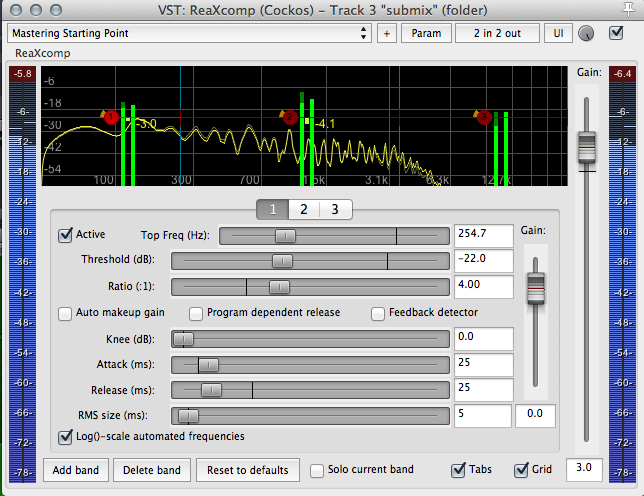A multiband compressor is a powerful tool for controlling dynamics. The signal is split into 3 or more frequency ranges and processed independently. This is different from a standard compressor which operates on the entire frequency range at once.
Standard compressors are great, but sometimes you’ll find that with any significant amount of gain reduction you start to get a very dull sound. With Multiband compression Each frequency range has an independent compressor so a source that has a lot of mid frequencies might end up with very little compression in the high frequencies, maintaining the brightness of the source.

Being able to apply different attack, release, ratio and makeup gain to low, mid and high frequencies gives enormous control. Unfortunately it can be tricky to set up it can do a lot of damage to the audio. It’s a tool you need to be extremely careful with. Used right it can be much more transparent than a standard single-band compressor.
There are two ways that I approach multiband compression.
The first way is to use about the same amount of gain reduction for each band, by adjusting the threshold individually.
The second way is to use the same threshold for all bands and let the compressor take care of what is standing out.
There are many multiband compressor plugins on the market, for my examples I’m using the one included in Reaper ReaXcomp and comparing it to the standard compressor ReaComp.
Example 1 – Drums
Here’s the drums with no compression.
[audio:http://audiogeekzine.com/wp-content/uploads/multiband_clips/drums_none.mp3|titles=Drums no compression]
I set the single-band compressor to get a punchy sound. Attack and release at 10ms and ratio of 4:1. The threshold is set at -19dB for about 3-6dB of gain reduction, then 2dB of makeup gain.
[audio:http://audiogeekzine.com/wp-content/uploads/multiband_clips/drums_comp.mp3|titles=Drums standard compression]
In that example you may have noticed some pumping. The compressor is squeezing down every time the kick hits. Using the highpass filter option in the compressor might help a little but let’s see how the multiband compressor handles it.
Using the same settings in the multiband compressor, each band is set to the same threshold of -19dB. The overall gain reduction is about the same, the lows and mid frequencies each getting about 3 dB of GR but the high band is barely doing anything.
[audio:http://audiogeekzine.com/wp-content/uploads/multiband_clips/drums_xcomp.mp3|titles=Drums multiband compression]
To me that sounds more punchy without pumping. The snare has more snap and something cool has happened with the blend of the distant mics.
Example 2 – Guitars
First clip is with no compression.
[audio:http://audiogeekzine.com/wp-content/uploads/multiband_clips/guitars_none.mp3|titles=Guitars no compression]
I’ve set up the single-band compressor to give me about 6dB of compression at most. 25 ms attack and release, 4:1 ratio, 3dB of makeup gain. I’m pushing it pretty hard so that the compression is more obvious.
Let’s have a listen
[audio:http://audiogeekzine.com/wp-content/uploads/multiband_clips/guitars_comp.mp3|titles=Guitars standard compression]
These guitars are pretty midrange heavy and pushing that down with compression has made it sound slightly darker and there’s some pumping again. Overall the frequency balance hasn’t changed too much which is good.
Using the multiband compressor should get rid of the pumping. With the same compressor settings copied into the multiband, there’s actually a little more gain reduction in the mid frequencies, nearly 7dB. 3-4 dB in the lows and about half a db in the highs.
[audio:http://audiogeekzine.com/wp-content/uploads/multiband_clips/guitars_xcomp.mp3|titles=Guitars multiband compression]
Dynamics controlled, no artifacts and the highs are nice and bright, what more could you ask for?
In these examples – Were the dynamics destroyed? No. Did it sound unnatural? Not at all, the multiband approach was actually less damaging to the audio. No pumping, no artifacts, and no loss of top-end.
Multiband compression seems to be something that is either underused or completely overused. A lot of people say it’s only for when a track has serious problems or to be used only for mastering. I disagree, I use multiband compression whenever I’m not getting what I need from a single band compressor.
At the end of the day I don’t really care what tool you use, just as long as you are getting the result you want. Don’t be afraid of multiband compression, don’t assume it’s overkill.
I learned a lot about using multiband compression from Ian Shepherd’s eBook Mastering with Multiband Compression, if you want to dig deeper into using them for mastering it’s definitely worth getting. I reviewed it here.

RT @theaudiogeek: New AGZ Post – How to use Multiband Compression: http://t.co/pW5KBHXd
RT @theaudiogeek: New AGZ Post – How to use Multiband Compression: http://t.co/U6Q1yAV4
How to use Multiband Compression http://t.co/gpJHF81G